
Background:
Early detection of disease allows for more treatment options and often results in better outcomes. Pet cancer is unfortunately a disease that can stay well hidden for a long time before becoming clinically evident, far into development. The Cancer Risk Assessment™ (CRA) is a blood test to screen apparently healthy dogs or cats for early signs of cancer and to evaluate if the pet is in a biological state that promotes the development of neoplasia.
Table of Contents
- Overview
- Role of Inflammation on Cancer
- Proliferation – a Hallmark of Cancer
- Developing the Cancer Risk Assessment
- Using the CRA in clinical practice
Overview
With a majority of dogs getting some type of cancer in their lifetime, developing a way to screen for cancer has high value. With this in mind, VDI developed the Cancer Risk Assessment – a dual-marker panel for the early detection of cancer and inflammation in dogs. Early detection of cancer leads to early intervention, access to more options, and better outcomes.
Role of Inflammation on Cancer
Cancer is an inflammatory disease. While acute inflammation is a critical process to fight pathogens and heal tissue damage, when it becomes chronic it creates an environment that stimulates, promotes, and propagates tumor growth. This makes identifying and resolving non-clinical inflammation critical especially in apparently healthy animals.
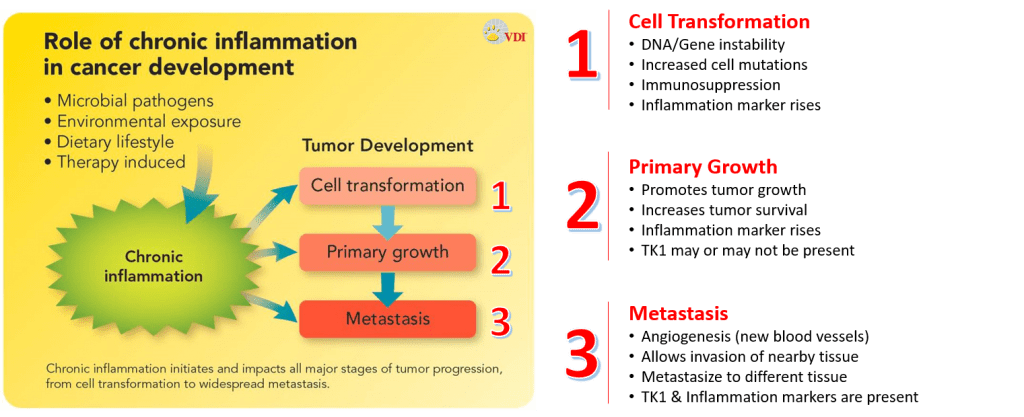
C-Reactive Protein
C-Reactive Protein (CRP) is the primary inflammation marker in dogs. In response to inflammatory triggers, CRP is produced by the liver. Once the source of inflammation is resolved, the CRP levels drop to near zero.
If the source is not resolved, or the body does not shut off the response mechanisms, CRP levels remain elevated – indicating chronic inflammation.
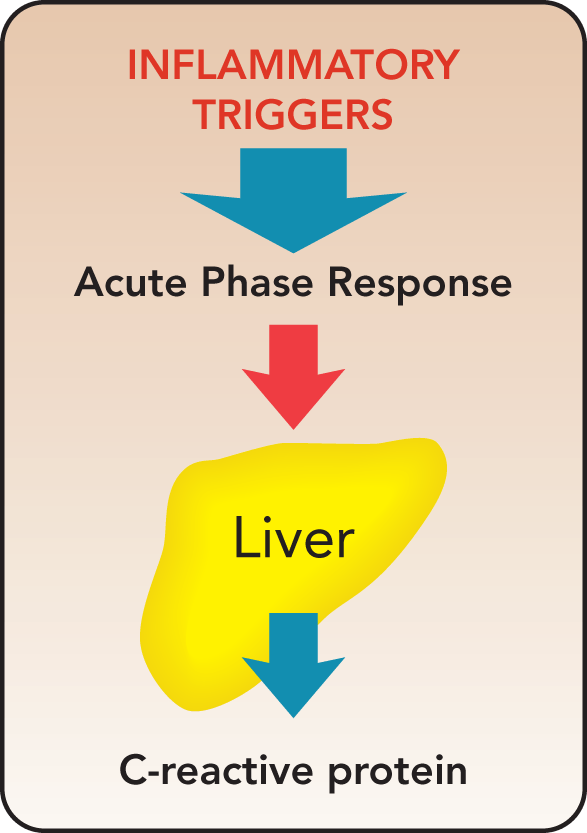
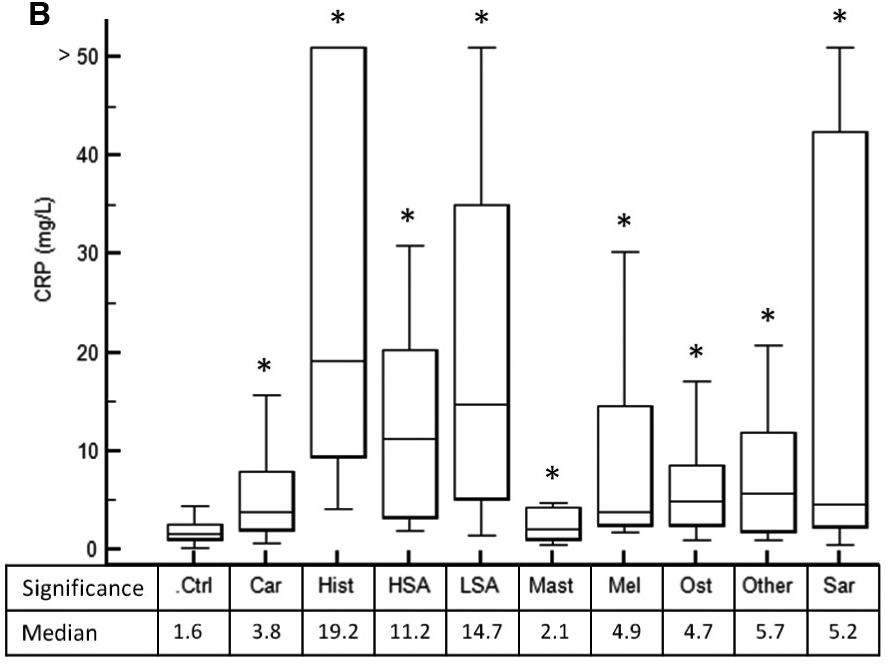
A study by Selting et al. examined canine specific C-reactive protein (cCRP) in a wide range of hematological and solid tumors.1 There were 253 tumor-bearing dogs and 156 without cancer.
Demonstrated here, CRP is elevated in various tumor types.
Proliferation – a Hallmark of Cancer
Cancer is a proliferation disease. Under normal conditions cells grow, exist, and die in a controlled manner. When aberrations arise, these cells can begin to proliferate in an uncontrolled way. This is a hallmark of cancer – dysregulated, uncontrolled cellular proliferation. Finding early indications that abnormal cell division is occurring is a feature of early cancer detection.
Thymidine Kinase Type 1
Thymidine Kinase Type 1 (TK1) is a proliferation marker. It is involved in the synthesis of DNA precursors and is correlated to the proliferative activity of tumor disease.
During abnormal cellular division, TK1 is leaked out of the cells, into the blood stream where it is normally not found.
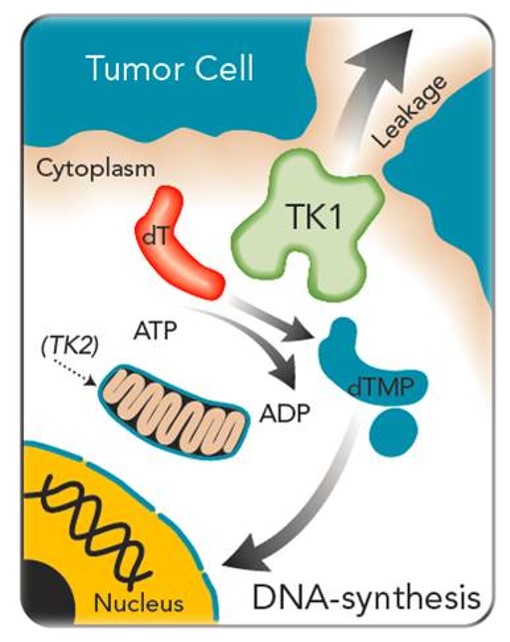
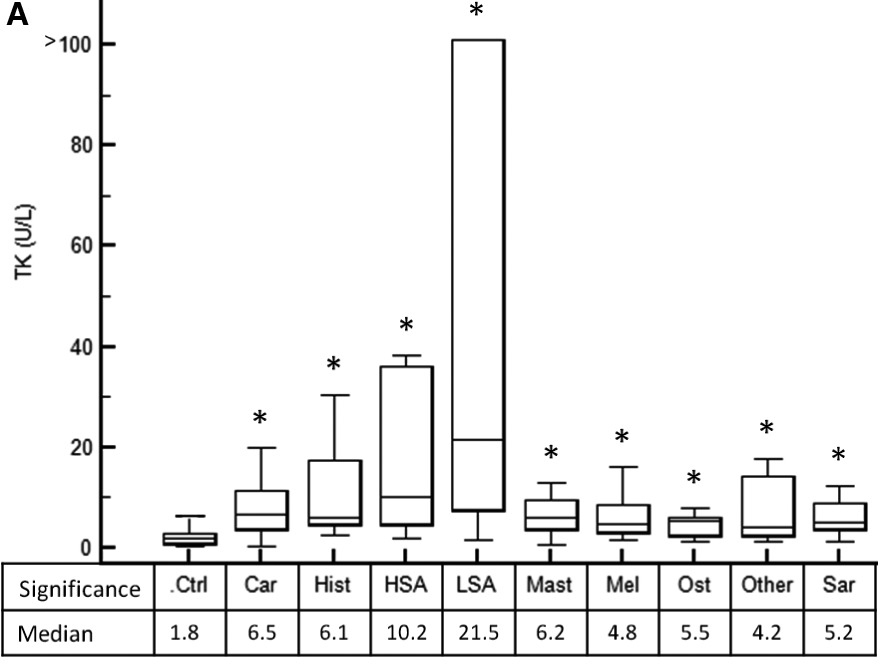
A study by Selting et al. examined Thymidine Kinase 1 in a wide range of hematological and solid tumors.1 There were 253 tumor-bearing dogs and 156 without cancer.
Demonstrated here, TK1 is elevated in various tumor types.
Developing the CANCER RISK ASSESSMENT™
The Cancer Risk Assessment (CRA), was developed as a result of recognizing that while transient acute inflammation defends, chronic inflammation is the root cause of many illnesses and actually propagates cancer. As much as the CRA is designed to detect cancer early, it has greater value in detecting chronic inflammation which can be managed before serious diseases develop.
Clinical Study
The Cancer Risk Assessment was developed from a large clinical study out of the University of Missouri.2 The initial intent of the study was to examine TK1 and CRP could be used to detect cancer in otherwise apparently healthy dogs but was expanded to look at overall health. In a large cohort of 360 dogs of high risk breeds followed for up to one year, both cancer and serious disease were identified.
This study showed 82% of all cancers were detected 6-months prior to clinical signs, and 100% of cancers were detected 4-months prior.
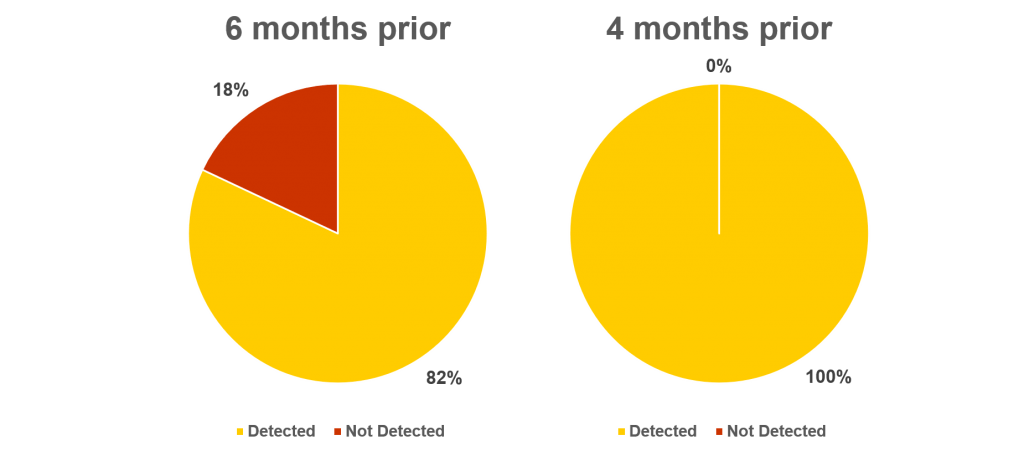
The study also showed that when inflammation was present, there was a 20% mortality rate within 6-12 months. When inflammation was not present, only 3% mortality rate. That’s a 7 fold increase.
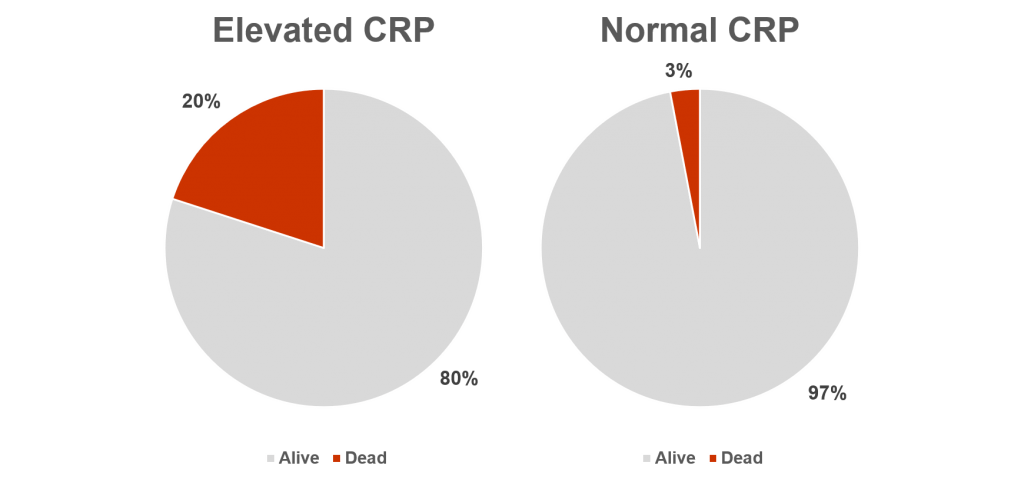
From this study the Cancer Risk Assessment (CRA) was created. The CRA is a stratification of cancer that integrates TK1 and CRP into a score from 0-10; the lower the score, the lower the risk.
Cancer Incidence with CRA scores
CRA Score: Cancer Incidence
0.0 – 5.4 : 0.6%
5.5 – 8.9: 19%
9.0 – 10.0: 40%
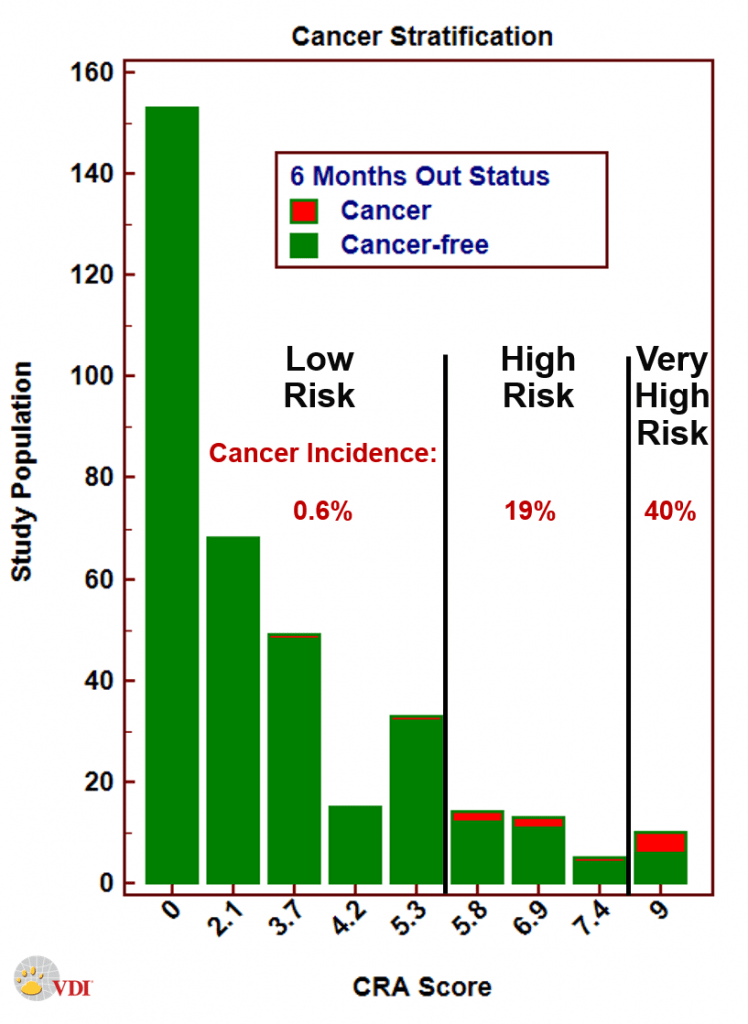
In this study, death was selected as a universal endpoint for serious disease. Certainly more dogs developed illness other than dying, but if you only looked at death, those with increasingly elevated CRP had a higher mortality rate, more than one quarter of the dogs, compared to those with low CRP.
Mortality increases with CRP level:
CRP (mg/mL): Death Incidence
0.0 – 2.0 : 3%
2.0 – 4.0: 5%
4.0 – 10: 19%
>10.0: 26%
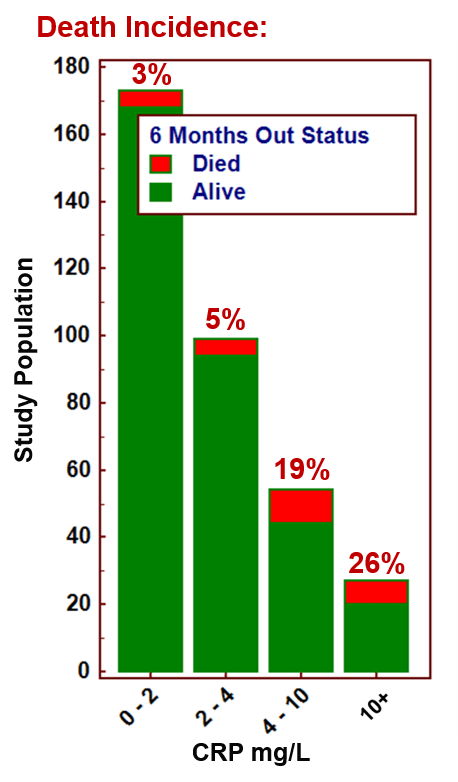
Cancer Risk Assessment Score
Taking the data from the clinical study, the CRA score was developed. CRA is a unitless index from 0 to 10 where 0 is a perfectly healthy, no cancer no inflammation dog, and 10 is a perfect score for cancer. As systemic inflammation increases and abnormal cell replication appears, cancer risk increases.
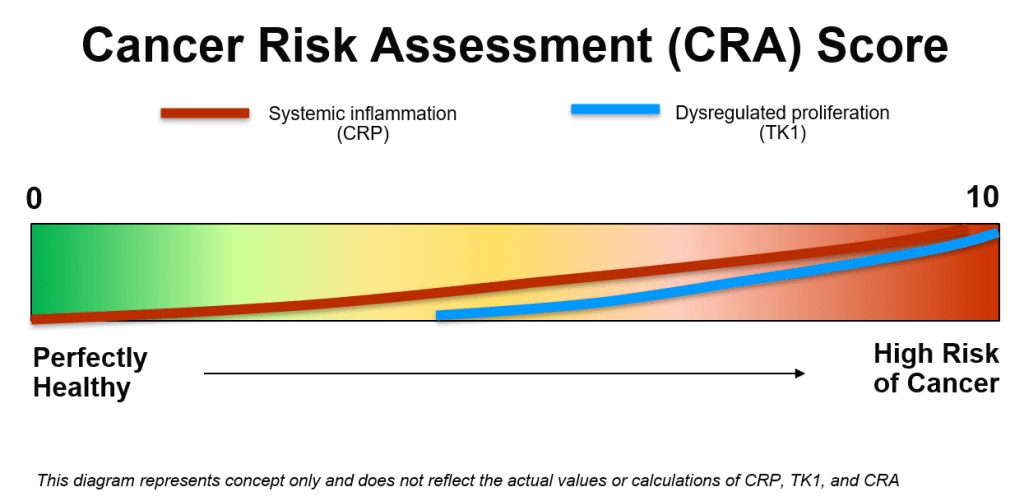
Screening not Diagnostics
The CRA is not a diagnostic test. It is not intended to diagnose cancer in a dog, but assess risk for likelihood of cancer developing in the next 4-6 months. For diagnostic rule-in of cancer, other tests such as the VDI Cancer Panel should be used. CRA is a screening test meant for the apparently healthy dog with no signs of cancer.
Using CRA Score in Clinical Practice
The Cancer Risk Assessment serves two main purposes: identify risk of cancer and evaluate if chronic inflammation exists. Early detection in apparently healthy dogs leads to early management and intervention.
When to recommend a CRA test:
- Apparently healthy dogs
- Over the age of 5
- High Risk Breeds (e.g. Golden Retrievers)
- Dogs with history of cancer in the line
How often to test:
- For best outcomes CRA should be evaluated every 4 months
- 6 months is a good compromise as 82% of cancers in the study were detected 6 months prior to clinical signs.
- Annual testing at minimum – anything beyond 6 months does not hold statistical value and is not included in the risk assessment.
Interpreting Results for your clients:
Low, Elevated, and High Risk results are not a cancer diagnostic and should not be taken as Code Red. Screening tests are designed to be sensitive not specific, so there are chances for false positives. Further discussion on understanding and using CRA can be found in the article: Cancer Risk Assessment – Understand, Implement, and Interpret.
References:
- Selting, K.A., Ringold, R., Husbands, B. and Pithua, P.O. (2016), Thymidine Kinase Type 1 and C-Reactive Protein Concentrations in Dogs with Spontaneously Occurring Cancer. J Vet Intern Med, 30: 1159–1166. doi:10.1111/jvim.13954
- Selting, K. A., Sharp, C. R., Ringold, R. and Knouse, J. (2013), Serum thymidine kinase 1 and C-reactive protein as biomarkers for screening clinically healthy dogs for occult disease. Veterinary and Comparative Oncology. doi: 10.1111/vco.12052
